 |
and is presented as JOM-e. Such articles appear exclusively on the web and do not have print equivalents. |
|---|
 |
and is presented as JOM-e. Such articles appear exclusively on the web and do not have print equivalents. |
|---|
 |
|---|
| CONTENTS |
|
|
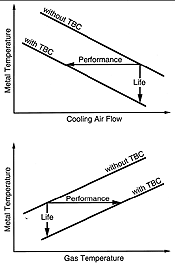 |
| Figure 1. Increased engine performance by TBC application showing (top) cooling air flow and (bottom) gas temperature as related to metal temperature. |
Plasma-sprayed (PS) TBCs have been widely applied to hot components like burner cans since the 1960s, while in recent applications of more complex parts like turbine blades, EB-PVD technology is favored. (Background on TBCs is provided in the sidebar.) During EB-PVD, a high-energy EB melts and evaporates a ceramic-source ingot in a vacuum chamber. Preheated substrates are positioned in the vapor cloud above where the vapor is deposited on substrates at deposition rates of 0.1-0.25 mm/s.3 Typical columnar microstructures and aerodynamically smooth surfaces are obtained without the need for final polishing or conditioning of cooling holes. Due to the columnar microstructure, the lifetime of the TBCs is prolonged and the damage tolerance improved. A selection of EB-PVD TBCs on aeroengine and stationary gas-turbine blades produced at the Deutsche Forschungsanstalt für Luft- und Raumfahrt (DLR) with semicommercial single-source 60 kW Leybold and dual-source 150 kW von Ardenne EB-PVD coaters is shown in Figure 2.
To better utilize TBCs in current or future applications as integral design elements of highly loaded engine parts, a more comprehensive understanding of the failure mechanisms of the coating systems is needed. Here, the influence of the chemical composition of the ceramic top coat on the performance of the TBC system is addressed. Examples are given on how the micro/macrostructure of ceramic coatings can be manipulated by modifying the EB-PVD processing parameters and how these alterations are reflected by the lifetime of the coating systems.
| HISTORY AND TRENDS IN TBC SYSTEMS | ||
| Since the early 1960s, plasma-sprayed calcia- and magnesia-stabilized zirconia TBCs have been used extensively as ceramic top coats on combustion-chamber walls and burner cans to prolong their lives by avoiding hot-spot formation and subsequent failure by thermal fatigue. These materials were broadly accepted for 20 years until their replacement by yttria-stabilized zirconia (YSZ) (~7 wt.% Y) coatings was initiated. The air-plasma sprayed (APS) YSZ TBCs offer outstanding mechanical, chemical, and thermal properties. Two generations of high-temperature (>1,000°C) TBCs were based on these unique ceramics (generation one is APS M-Cr-Al-Y/APS 7 YSZ and generation two is low-pressure plasma-sprayed [LPPS] M-Cr-Al-Y/APS 7 YSZ), which, in the early 1980s, enabled TBCs to be introduced on highly thermally loaded parts like vane platforms and vane airfoils. The need for higher operating temperatures in turbines, however, inspired material scientists to search for TBCs that could also be applied on blade platforms and airfoils subjected to high thermal loads as well as additional mechanical strains.
Under these circumstances, the EB-PVD technology offered the opportunity to generate TBCs with vastly superior strain tolerance. This property is due to the specific coating structure that grows from the vapor phase in a columnar form with individual ceramic columns being weakly bonded to their neighbor columns. The columns exhibit a preferred {100} orientation. The technical importance of this is twofold: namely, a higher coefficient of thermal expansion for the in-plane direction, which allows a better fit to the bond coat, and a lower in-plane Young's modulus, which provides more stress relief on thermomechanical loading at the interface. Coating all of these high-performance parts with reliable TBCs would optimize the initial component design and make coatings an integral part of the component. In 1987, the exploitation of strain-tolerant TBCs initiated a renaissance of industrial EB-PVD technology, which had been previously utilized for depositing metallic M-Cr-Al-Y coatings for more than 20 years. The novel EB-PVD YSZ ceramic layers with an LPPS Ni-Co-Cr-Al-Y bond coat (designated generation three) offer a roughly three-fold improvement in blade life or a surface temperature increase on the hot sections of foils of approximately 150 K. Failure in TBC systems almost always occurs by TBC spallation due to stresses in the ceramic or bond coat. But failure of these new EB-PVD processed TBCs happens, unlike those for plasma-sprayed TBCs, at the ceramic-bond coat interface. There is a thermally grown oxide (TGO) of a few micrometers in thickness that plays a key role in the adhesion of EB-PVD TBCs. The TGO is the weak link in the system and its strength and adhesion to the bond coat governs the location of failure and whether first cracks will propagate within or along the TGO-bond coat interface. Here, spallation is initiated by the accommodation of stresses surmounting a critical value. A route to minimizing misfit stresses is reducing the growth rate of TGOs. The early-overlay bond coatings, which were EB-PVD M-Cr-Al-Y coatings, were followed by plasma-sprayed M-Cr-Al-Y families. Up-to-date M-Cr-Al-Y coatings contain additional elements like silicon and/or tantalum and hafnium to provide lower scaling rates and better hot-corrosion resistance. These coatings with some low-vapor-pressure elements (which are mainly refractory elements) are more easily deposited by LPPS techniques. These formulations let TGOs grow more slowly and, thus, prolong the lifetime of the TBCs. Another route to minimize misfit stresses and to improve spallation resistance is to make the bond coatings more creep-resistant, which will bring more stability to the TBC root area on thermomechanical cycling. This change in mechanical characteristics is successfully done in LPPS M-Cr-Al-Y overlay coatings by converting the former g/b phase structure into a g/g' structure by appropriate alloying. The modified phase structure provides high creep resistance as does the introduction of a significant portion of refractory elements. Two more benefits are low diffusivity and a reduced coefficient of thermal expansion. The last property is of uppermost importance as it controls the amount of residual stresses that can accumulate in the TGO layer. In essence, the residual stresses can be kept low if the differences between the coefficients of thermal expansion of the respective ceramic and metallic partners of the whole system are minimized. Thus, the involvement of superalloy substrates in the interplay of the physical properties of the respective material components and their influence on the compositional behavior of TBC systems has to be addressed. Nickel-based superalloys have gained a high degree of technical maturity in the early 1990s. They have passed many developmental stages (e.g., hardening by precipitated g' phases, extensive solid-solution strengthening, and directional solidification and/or transformation to single crystals to obtain more creep-resistant crystal orientations and continuous-grain structures). The most creep-resistant crystal orientation (001), however, provides the lowest Young's modulus (120 MPa). It is a drawback for the adhesion of TBCs since thin-walled airfoils under constant load can be bent more rigorously in service than the conventionally cast counterparts. Three generations of single-crystal superalloys, however, resulted in a reduction of coefficient of thermal expansion that compares with the recent low-expansion bond coats.
Future applications of TBCs aim at surface temperatures of 1,250°C and above, where turbine engines as well as industrial turbines, will operate. The YSZ ceramics, however, exhibit destabilization of the t' phase to m + c on extended exposure above 1,150°C, and sintering phenomena become predominant. Alternative ceramics that have even lower sintering rates, better phase stability, and lower thermal conductivity will be needed for substitution. The need for new ceramic materials will force EB-PVD processing developments to overcome pertinent materials restrictions. Multiple-source, high-rate coaters will be a valuable tool in this context to enable the production of TBCs that are composed of low and high vapor-pressure components (Figure A). This equipment also allows for the production of the very recent bond-coat compositions that may contribute to the manufacture of safer TBC systems. The coating market has become highly dynamized. New microstructures encompass compositionally graded, density graded, and multilayered arrangements where, especially in the last case, a reduced heat conduction may allow the application of thinner overlays. CVD techniques can be employed for their particular thin-layer virtues. In any case, basic and applied research capabilities have to focus on alternative materials and processing routes that focus on cost requirements. Finally, nondestructive testing and life-prediction methodologies for TBC systems must be furnished. |
To get more insight into the single-source EB-PVD processing of new compositions for TBCs, a feasibility study was performed on four differently stabilized zirconias using identical substrate alloys and EB-PVD Ni-Co-Cr-Al-Y bond-coat compositions: PYSZ 6.5 wt.% Y2O3; fully yttria-stabilized zirconia (FYSZ),-20 wt.% Y2O3; LaSZ-8 wt.% La2O3; and CeSZ-25 wt.% CeO2 with 2.5 wt.% Y2O3.
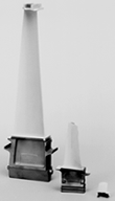 |
| Figure 2. EB-PVD TBC turbine blades used in (left to right) stationary gas turbines, civil aeroengines, and helicopter engines. |
The deposition temperature was nearly the same for all four zirconia versions, however, their melting points differ widely, thus evolving different microstructures according to the structure-zone models mentioned. Other effects that affect the microstructure include variations in phase composition, ion radii, and surface-energy aspects during condensation.11
Phase analyses by x-ray diffraction (XRD) revealed that the compositions of the three binary TBCs, PYSZ, FYSZ, and LaSZ were close to the ingot compositions. For PYSZ, exclusive tetragonal (t') phase was identified, while FYSZ contained exclusive cubic (c) phase. LaSZ exhibited a mixture of mainly t', minor c, and substantial amounts of monoclinic (m) phase. In the case of the ternary composition ZrO2-CeO2-Y2O3, however, analysis showed a fluctuating composition across the TBC thickness. Due to these variations, the surface content of ceria varied among test pieces of different deposition runs between 13-38 wt.%. For CeSZ, a mixture of c, t', and, occasionally, m phases was found.11
These four differently stabilized TBCs were subjected to cyclic-burner rig testing at Mach 0.35 gas velocity with cyclic heating up to 1,150°C for 57 minutes and forced cooling to room temperature for three minutes. The results are summarized in Figure 3. Rapid spallation of FYSZ and LaSZ TBCs was observed, as characterized by high weight losses after short testing times. PYSZ proved to be the most stable coating system over long times, followed by sudden spallation of the TBC. CeSZ exhibited a different behavior, in which a quasicontinuous weight loss was observed after each inspection cycle. The different failure mode of CeSZ in comparison to a standard spallation failure exhibited by PYSZ is visible in Figure 4. A step-wise degradation in layers was observed for the CeSZ TBCs instead of spallation of the whole TBC in a single event, as noticed in all other cases. A thin layer of ceramic was still present on top of the bond coat after the tests. Considering the lifetime of the TBCs, a similar ranking was also found in cyclic-furnace tests between 150°C and 1,100°C. However, for all stabilizers, the main failure location was between the thermally grown oxide and the bond coat rather than between the thermally grown oxide and TBC.
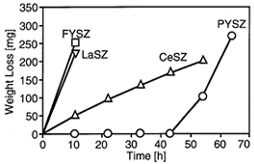 |
| Figure 3. The weight loss of cyclically burner-rig tested samples versus time. |
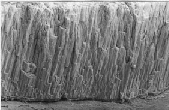 |
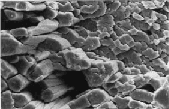 |
| Figure 4. Scanning electron microscopy images of burner-rig tested TBCs—(a) PYSZ (cross section) and (b) CeSZ (surface image)—after 65 hours at 1,150°C. |
The literature indicates that a single cubic phase is formed for FYSZ TBCs with EB-PVD as well as PS TBCs. FYSZ suffers from low thermal shock resistance and poor fracture properties of the equilibrium c phase. Earlier reports on PS TBCs15,16 have shown that FYSZ possesses poor thermocyclic behavior; however, some inconsistency in the literature on TBCs of this composition must be recognized. Our results support findings17 that the columnar EB-PVD structure is not able to overcome the intrinsic problems of FYSZ, leading to the poor integrity of such coatings after cyclic testing (Figure 3).
Monoclinic phases that undergo a phase transformation during temperature variation will cause rapid spallation of EB-PVD TBCs. The volume change that is connected to the phase transformation m t creates high stresses. Even strain-tolerant structures like those found in columnar EB-PVD TBCs are not able to accommodate these stresses on transformation. Early spallation of LaSZ gives clear evidence for such a failure mechanism. It has to be taken into account that high-rate condensation from a vapor phase is not necessarily a process that stabilizes equilibrium phases. Therefore, phase diagrams do not allow a safe prediction of the phases of real coatings.
t creates high stresses. Even strain-tolerant structures like those found in columnar EB-PVD TBCs are not able to accommodate these stresses on transformation. Early spallation of LaSZ gives clear evidence for such a failure mechanism. It has to be taken into account that high-rate condensation from a vapor phase is not necessarily a process that stabilizes equilibrium phases. Therefore, phase diagrams do not allow a safe prediction of the phases of real coatings.
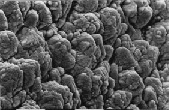 |
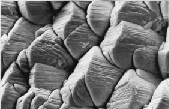 |
| Figure 5. Surface of YPSZ TBCs at (a) 980°C for 12 min.-1 and (b) 1,050°C for 30 min.-1. |
Still, burner-rig results of CeSZ were promising (Figure 3). Quasicontinuous weight loss and degradation of the CeSZ TBCs in thin layers were found, but no spallation. One reason for a step-wise loss is the fluctuation of composition across the thickness of the TBC. This may cause alternating layers of weak phases, including m phases and strong phases like t'.13 Apparently, the coating will first break in weaker regions. Lattice misfits between the various layers may further contribute to reduced adhesion between the layers. Higher erosion rates of CeSZ found for PS TBCs7,20 may also account for this failure mode. The partial loss of this TBC may act as a strain/stress relief mechanism that allows the remainder of the coating, which is now thinner due to partial spallation, to adhere longer. CeSZ apparently offers some potential in TBCs, especially if a columnar microstructure can be utilized. Single-source EB-PVD proved unsuccessful so far, while two-source evaporation may bring about reproducible CeSZ TBCs of stable composition. The first tests of dual-source evaporation of ceramics using jumping-beam technology are promising.
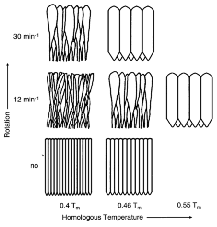 |
| Figure 6. A schematic of the influence of substrate temperature and rotational speed on columnar microstructure evolution of EB-PVD TBCs. |
The microstructure can be varied without altering the deposition temperature by different rotational speeds. At low rotational speed, the beaded structure is formed within the columns while it disappears immediately after changing to a higher speed. An increase of column diameter was also found. This processing tool allows the manufacture of microstructurally graded TBCs that can be adapted to create appropriate column features in particular TBC thickness zones. Several aspects may contribute to the observed effects, including surface-temperature fluctuations, diffusion kinetics changes, and enlarged shadowing due to rotation. For instance, measurements of actual surface temperatures on flat samples during deposition gave temperature differences of 60-80°C for a low rotational speed as compared to 15-25°C when speed was increased threefold.
These observations suggest that structural-zone diagrams should be modified when substrates are rotated during deposition. We propose to incorporate a second axis in the models as a further degree of freedom, similar to sputtered coatings where the role of argon pressure was considered. To give an idea of a potential model improvement, the observed microstructures for the interval of homologous temperature investigated are summarized in Figure 6.
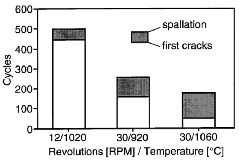 |
| Figure 7. Cyclic lifetime in a furnace test. |
In the hot-corrosion testing of EB-PVD TBCs, no evidence was found for the hot corrosion of the bond coat or for a chemical reaction between the TBC and corrosion accelerators like molten salts and sulfur compounds.5,24 However, TBC failure can be initiated by mechanical attack of solidified salt compounds. Spallation of small areas of TBC in a funnel-shaped manner with some thinner coating still adherent on the bond coat supports this failure mechanism. For columns that possess larger voids between the interior column faces, salts may penetrate deeper into the coating than in denser columnar microstructures. Consequently, the weight loss is higher for a coarser microstructure deposited at a higher rotational speed as compared to a microstructure deposited at a lower temperature and rotational speed.24
K. Fritscher earned his Ph.D. in metallurgical engineering at the Technical University of Berlin in 1970. He is currently a senior scientist at the Deutsche Forschungsanstalt für Luft- und Raumfahrt, Institute of Materials Research in Germany. He is also a member of TMS.
C. Leyens earned his Ph.D. in materials science at RWTH Aachen in 1997. He is currently a research scientist at the Deutsche Forschungsanstalt für Luft- und Raumfahrt, Institute of Materials Research in Germany. He is also a member of TMS.
M. Peters earned his Ph.D. in metallurgical engineering at the University of Bochum in 1980. He is currently head of the coating section at the Deutsche Forschungsanstalt für Luft- und Raumfahrt, Institute of Materials Research in Germany. He is also a member of TMS.
W.A. Kaysser earned his Ph.D. in materials science at the University of Stüttgart in 1978. He is currently a professor at the Technical University of Aachen and the director of the Deutsche Forschungsanstalt für Luft- und Raumfahrt's Institute of Materials Research in Germany. He is also a member of TMS.
For more information, contact U. Schulz, Deutsche Forschungsanstalt für Luft- und Raumfahrt, Institute of Materials Research, D-51170 Köln, Germany; fax 49 2203 696480; e-mail Uwe.Schulz@dlr.de.
Direct questions about this or any other JOM page to jom@tms.org.
| Search | TMS Document Center | Subscriptions | Other Hypertext Articles | JOM | TMS OnLine |
|---|